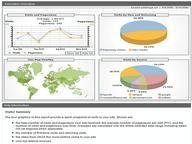Quiz Answer Key and Fun Facts
1. I label an x-axis with points earned (using ranges of points) and the corresponding y-axis with number of players (again using ranges). I plot one against the other and I obtain a bar graph called a what?
2. I now fit a smooth curve to the tops of the bars in my graph of points earned on the x-axis and player numbers on the y-axis. What have I obtained?
3. What is the area under the curve of any probability distribution called?
4. The mean or average score is higher than the median, which is obtained by ranking the scores and selecting the one in the middle. How does this affect the shape of the curve?
5. This game assigns fifteen points for each correct answer. What is the most likely reason for this?
6. In playing a FunTrivia game, you discover that you make rapid progress through the lower rankings but once you get higher, you can only gain a few ranks per day, if at all. Why is that?
7. The game has no penalty for guessing on a multiple choice item. "Penalty for guessing?" you say. "How would that work?" Which of these is a way of implementing a penalty for guessing?
8. How would adding a great many more randomly selected players change the probability distribution of scores?
9. As you advance through the rankings, you notice that the gap between you and the next player is widening, if ever so slightly. It may now take you 20 points to advance rather than 10. What is the reason for that?
10. Hypothetically, this game has 10,000 players, so the probability of being the sole holder of the highest score is 1/10,000. A friend tells you that aspiring to that score is like trying to win the lottery. What is (primarily) wrong with that analogy?
Source: Author
jbuck919
This quiz was reviewed by FunTrivia editor
crisw before going online.
Any errors found in FunTrivia content are routinely corrected through our feedback system.

